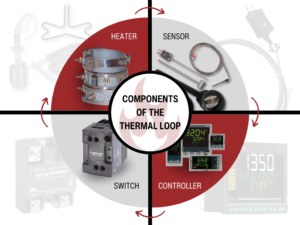Authored by Isabel McCord
The Four Components of the Thermal Loop
In the world of plastics manufacturing, the thermal loop stands as a critical process, directly influencing product quality, production efficiency, and overall process stability. With its four interconnected components, the thermal loop ensures precise temperature control throughout the entire production cycle. Let’s dive into the components of the thermal loop and meet the key players: sensors, controllers, switches, and electric heaters.
1. Sensors: The Temperature Detectives
Imagine tiny temperature detectives – thermocouples and RTDs (temperature-sensing resistors) – stationed throughout the process, constantly monitoring the material and machinery. These sensors are the eyes and ears of the thermal loop, providing real-time updates on temperature to the control center.
- Thermocouples: Made of two different metals joined at one end, thermocouples generate a voltage proportional to the temperature difference when exposed to heat. Their responsiveness to rapid temperature changes makes them ideal for injection molding, where precise and quick temperature measurement is crucial for achieving the desired shape and surface finish of plastic part
- RTDs: Made of a pure metal (typically platinum), exhibit a predictable change in electrical resistance with temperature. RTDs offer exceptional accuracy and stability over a wide temperature range, making them perfect for demanding applications where precision is paramount. For instance, in extrusion processes, RTDs help maintain consistent material flow and prevent defects like under- or over-extrusion.
2. Controllers: The Masterminds
Meet the masterminds behind the scenes – temperature and pressure controllers. These high-tech brains process the data from the sensors and make split-second decisions to adjust the heating or cooling systems. Think of them as the conductors of a symphony orchestra, ensuring every instrument (or heating element) plays its part perfectly.
- Temperature Controllers: These diligent overseers compare the actual temperature to the desired setpoint and adjust the heating or cooling elements accordingly. Using control algorithms like PID (Proportional-Integral-Derivative), they optimize temperature stability and response time. In thermoforming, precise temperature management controlled by temperature controllers is crucial for creating accurate and durable plastic products.
- Pressure Controllers: Maintain the system within safe and efficient operating limits. They regulate the flow of materials or gases to ensure consistent pressure levels, preventing fluctuations that could impact product quality or equipment performance. Pressure controllers play a vital role in injection molding, ensuring even distribution of molten plastic within the mold cavity.
3. Electric Heaters: The Muscle
Electric heaters are the muscle of the thermal loop, converting electrical energy into thermal energy to heat the plastic material. Let’s delve deeper into some of the most common types:
- Cartridge Heaters: Cartridge heaters are cylindrical heating elements inserted into drilled holes in the equipment. They offer precise heat delivery and are available in various lengths, diameters, and wattages.
- Advantages: Compact size, precise heat control, and easy installation.
- Applications: Commonly used in molds, dies, and extrusion equipment for localized heating.
- Types: Stainless steel, copper, and sheathed cartridges, with different wattage densities and temperature ratings.
- Band Heaters: Band heaters are flexible heating elements that wrap around cylindrical surfaces, providing even heat distribution. They are available in various widths, lengths, and voltages.
- Advantages: Versatility, easy installation, and even heat distribution.
- Applications: Commonly used in extrusion barrels, pipes, and hoses for maintaining consistent temperatures.
- Types: Mica band heaters, ceramic band heaters, and mineral insulated band heaters.
- Cast-In Heaters: Cast-in heaters are embedded directly into the equipment, offering superior heat transfer and durability. They are typically made of aluminum, bronze, or iron and can be customized to fit various shapes and sizes.
- Advantages: Excellent heat transfer, long lifespan, and resistance to harsh environments.
- Applications: Commonly found in extrusion barrels, hot runner systems, and other applications requiring consistent and reliable heating.
- Customization: Cast-in heaters can be tailored to specific heat output, shape, and mounting requirements.
- Infrared Heaters: Infrared heaters use radiant energy to transfer heat to the target material. They offer precise heat control and rapid heating times.
- Advantages: Non-contact heating, fast response times, and energy efficiency.
- Applications: Widely used in preheating, drying, curing, and forming processes.
- Types: Ceramic infrared heaters, quartz infrared heaters, and shortwave infrared heaters.
- Tubular Heaters: Tubular heaters are cylindrical heating elements composed of a resistance wire encased in a metal sheath. They are versatile and find application in various heating processes.
- Advantages: Even heat distribution, durability, resistance to corrosion, customizable shapes and sizes.
- Applications: Heating liquids and gases, Mold heating, Plastic extrusion, Chemical processing.
- Types: Straight tubular heaters, U-shaped tubular heaters, Immersion tubular heaters
- Strip Heaters: Strip heaters are flexible heating elements that can be easily installed on various surfaces. They come in different widths, lengths, and wattages to accommodate diverse heating needs.
- Advantages: Versatility, easy installation, and precise temperature control.
- Applications: Used in molds, platens, and other equipment requiring localized or uniform heating.
- Types: Silicone rubber strip heaters, finned strip heaters, and mica strip heaters.
4. Switches: The Power Players
Switches are the power players in the thermal loop, controlling the flow of electricity to the heating elements.
- Solid-State Relays (SSRs): These use semiconductor components to switch electrical loads on and off without any moving parts, resulting in lightning-fast response times, high reliability, and long lifespans, making them the preferred choice for demanding applications.
- Mercury Relays: While gradually being phased out due to environmental concerns, mercury relays have been workhorses in the industry for decades. They offer exceptional durability and the ability to handle high current loads, making them suitable for heavy-duty applications.
Conclusion
The beauty of the thermal loop lies in the seamless collaboration of these components. Sensors gather vital temperature data, controllers make informed decisions, switches deliver the power, and heaters provide the heat. It’s a well-orchestrated dance that results in consistent product quality, maximum efficiency, and reduced energy consumption. By understanding the role of each component and how they work together, plastics manufacturers can fine-tune their thermal processes for optimal performance.












